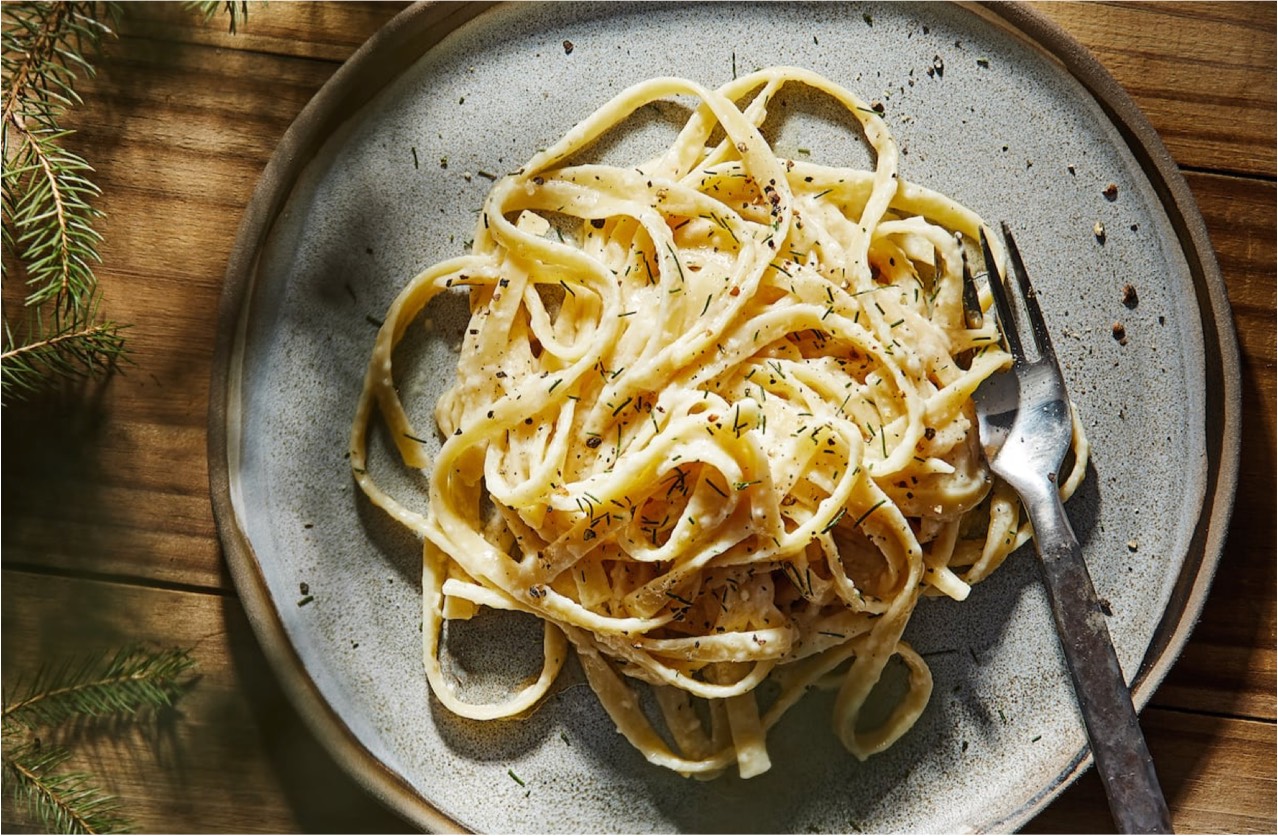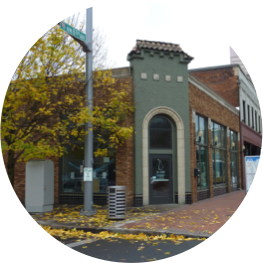As a homeless teen, I foraged for wild food to survive. The lessons still shape my cooking.
November 27, 2020
November 27, 2020

A moving read (with a tasty recipe!) by talented former p:ear youth, Sabra. We are so proud of you and the beautiful life you’ve cultivated, Sabra! Sending love from your p:ear fam.
As a homeless teen, I foraged for wild food to survive. The lessons still shape my cooking.
By Sabra Boyd
November 27, 2020 at 7:00 a.m. PST
Etta James sings about a Sunday kind of love as I pour a tiny mountain of flour onto the kitchen table. I push a crater into the center and crack an egg. One should be enough. I can always add more if the texture crumbles. Desperate times call for comfort food. And whenever I have time, making fresh pasta helps me embrace being home.
If I have dry pasta on hand, I toss that into a boiling pot. But rolling out fettuccine noodles is the only kind of meditation I have patience for these days. I press my hands firmly into the dough, feeling grateful to have a kitchen. I coat the rolling pin in extra flour and think about how, as a homeless teenager 20 years ago, I cooked using only a backpacking stove. Surviving teen homelessness prepared me for a pandemic in ways I never could have imagined.
My mother first kicked me out when I was 14, after my little brother announced that I was gay. (The fact that I am bisexual didn’t seem to make much difference.) We had recently moved to Port Angeles, Wash., the land of “Twilight” and Raymond Carver, to help care for my grandfather after his stroke. I didn’t know anyone to crash with, so I trudged uphill to the dark high school because I could not think of anywhere better to go other than the place I needed to be in the morning. I climbed the roof of the auditorium and took a clumsy parkour leap from the eave of my English classroom’s window. Tracing constellations with my finger, I pulled my hoodie tight against the cold. The glare of a neon crucifix, perched on a hill above the school, flooded the football field with light. I closed my eyes and tried to fall asleep.
The following night, I sneaked into my mom’s house through a window and packed my camping gear. I set up my new home in a cave above the Elwha River. Sometimes I slept in an abandoned house in Eden Valley. When it grew too cold, I stayed at a hippie commune, in the goat stable, but I left when the commune became too dangerous. I returned periodically to check on my younger siblings, but Mom would fly into an alcoholic rage, so I spent most of high school homeless.
With the pasta dough rolled out, I carefully cut long, uniform lines. I toss the pasta with a handful of flour and think about the foods I used to prepare in the cave. I kept my favorite nonperishables in a bear canister: instant noodles, dehydrated miso soup, granola bars and halvah. In the spring, I sauteed fiddleheads and horsetails in olive oil with my compact camp stove. In summer, I gorged on blackberries, delicately picked bright red thimbleberries and, when their pink blossoms fell, hunted for the electric hue of salmonberries. In the fall I gathered apples from wild orchards and scanned the sepia leaves on the forest floor, training my eye for a pop of yellow chanterelle.
In winter I relied more on eating lunch at school and at work, or restocking my canister with trips to the co-op near my many after-school jobs. I worked as a barista, landscaper, maid, caregiver, caterer and pastry chef. I also volunteered for Olympic National Park’s revegetation crew and as a tour guide at the local aquarium. Volunteering and working all the time distracted me from everything going wrong in my life — plus, I hoped it would help me get into a good college far away. Volunteering also meant I could spend a few extra hours indoors if it was raining or cold outside.
Despite working seven days a week, I could never save enough money to persuade a landlord to rent an apartment to a 14-year-old girl and her two siblings.
Striving to make fewer trips to the grocery store during the coronavirus pandemic has pushed me to become more creative and less precious about my culinary endeavors. Preparing meals every day at home with my husband has become a welcome interruption of our work-from-home schedules. We take turns making pots of beans for lunch, salads or unfussy sandwiches. Being unable to host elaborate dinner parties with friends while social distancing has freed me from any self-imposed pressure to make the complicated courses that I used to punctuate the week with.
My dog wakes up from her nap in a sunbeam. She stretches, sniffing in the direction of the pasta. I am making Douglas-fir fettuccine Alfredo, or fettuccine al burro, named for its rich butter sauce, because the weather has turned cold and there is not much else to forage. The bright citrus tang of Doug fir is welcome when the days turn dreary, and I use it as a wild alternative to rosemary.
When I lived alone in the woods as a teenager, I used to steep a piney tea to stay warm. These days, my dog trots behind me as I search for a tree in our neighborhood with branches low enough that I can reach. The leaves are most tender in the spring when they are neon, but they can be harvested year round, making this literally an evergreen recipe. The first rule of foraging is to be certain that you know what you are eating, because otherwise it can be dangerous. I wash the sprigs and pluck away the stem running through the center, just like rosemary. My chef’s knife rocks back and forth on the cutting board, mincing the vivid green spice and filling the house with a scent like sunlight. Measuring half a teaspoon to cook in the Alfredo, I set the rest aside. Adding the herb as a garnish provides a colorful contrast and preserves the lemony flavor that can otherwise disappear with the heat. Steam rises from our plates, and I think about the ways in which creativity and curiosity have always helped me persevere.
The kitchen is a mess now, with sauce spilled across the stovetop and a mountain of dishes piled in the sink. But I ignore it all for now and sit down with my family. Maybe it’s the warm hygge plate of carbs, or perhaps the citrus-forest scent. But for a moment, these small joys make me feel happy, safe and hopeful.
Recipe
Storage Notes: Leftovers can be refrigerated in an airtight container for up to 4 days.
Before foraging for Douglas fir, or for any wild food, be sure you are properly identifying the plant. Not all plants are edible.
Ingredients
Kosher salt
1 pound fettuccine pasta
8 tablespoons (1 stick) unsalted butter, cut into 8 pieces
1 cup (about 3 ounces) grated Parmesan cheese
1 teaspoon minced Douglas fir needles, divided (may substitute fresh rosemary)
Freshly cracked black pepper, for garnish (optional)
Step 1
In a large pot of salted boiling water over medium-high heat, cook the pasta according to package instructions, until al dente. Drain, reserving 1 cup of the pasta water.
Step 2
In a large saucepan over low heat, melt the butter. Add the cheese and whisk until the cheese has melted.
Step 3
Add 3/4 cup of the hot pasta water to the butter-cheese slurry, raise the heat to medium and whisk until the mixture is slightly reduced and uniform, about 5 minutes. If the sauce is too thick, whisk in additional starchy water 1 tablespoon at a time. Taste, and adjust the salt as needed. Add 1/2 teaspoon Douglas fir or rosemary and stir to combine.
Step 4
Add the drained fettuccine to the saucepan; gently toss to combine.
Step 5
To serve, divide among the plates and garnish with the remaining 1/2 teaspoon Douglas fir or rosemary. Top with a pinch of freshly cracked black pepper, if desired.
Nutrition Information
Calories: 399; Total Fat: 29 g; Saturated Fat: 18 g; Cholesterol: 103 mg; Sodium: 404 mg; Carbohydrates: 21 g; Dietary Fiber: 1 g; Sugar: 1 g; Protein: 13 g.
Adapted from a recipe by Sabra Boyd.

